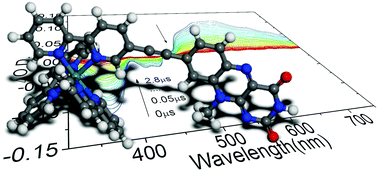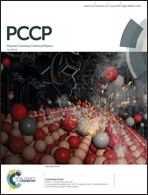Synthesis and photophysical properties of ruthenium(ii) polyimine complexes decorated with flavin†
Abstract
A bipyridine ruthenium(II) complex (Ru-1) with a flavin moiety connected to one of the bipyridine ligands via an acetylene bond was designed and synthesized, and its photophysical properties were investigated. Compared with the tris(bipyridine) Ru(II) complex (Ru-0), which has an extinction coefficient ε = 1.36 × 104 M−1 cm−1 at 453 nm, the introduction of the flavin moiety endows Ru-1 with strong absorption in the visible range (ε = 2.34 × 104 M−1 cm−1 at 456 nm). Furthermore, Ru-1 exhibits phosphorescence (λem = 643 nm, ΦP = 1%, τP = 1.32 μs at 293 K and 4.53 μs at 77 K). We propose that the emission of Ru-1 originates from the low lying triplet excited state of 3IL according to the time-resolved transient difference absorption spectra, the calculated T1 spin density and the T1 thermo-vibration modes localized on the flavin-decorated bipyridine ligand. This is the first time that the phosphorescence of flavin was observed within Ru(II) complexes. Consequently, Ru-1 was used for triplet–triplet annihilation upconversion, showing a reasonable quantum yield of 0.7% with respect to the phosphorescence quantum yield of 1%. These findings pave the way for the rational design of phosphorescence transition metal complexes. Also, further approaches that may improve the performance of flavin-decorated Ru(II) bipyridine complexes are proposed.



 Please wait while we load your content...
Please wait while we load your content...